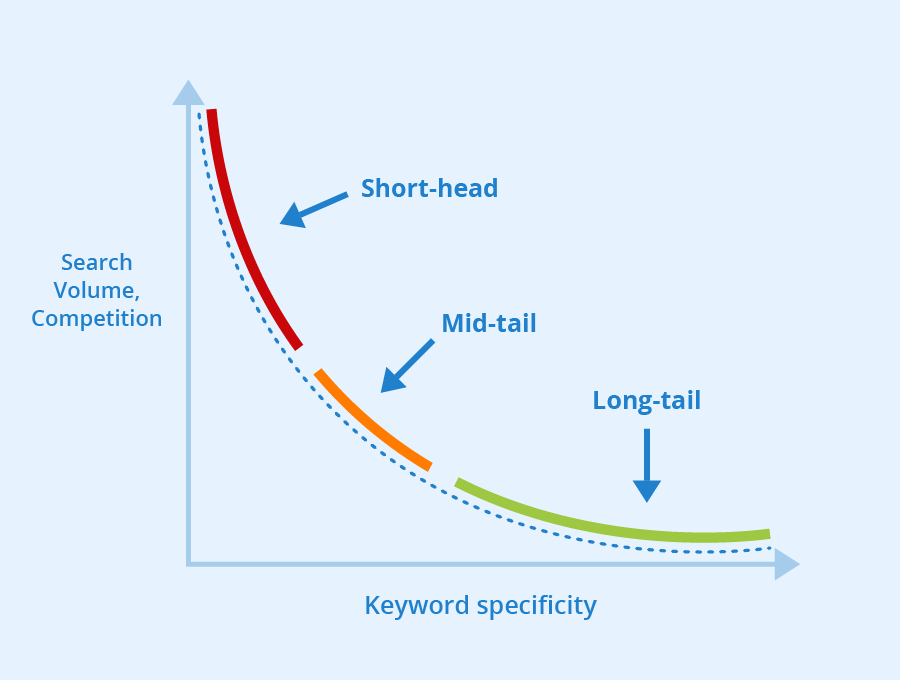The Ultimate Guide to Long-Tail Keywords
By RG team · 14 min read
Last Updated on June 27, 2023
Wait a minute...

Introduction

Photo by Clem Onojeghuo on Unsplash
Welcome to the world of long-tail keywords, where specificity meets success in the realm of search engine optimization (SEO). In today's digital landscape, content creators have a lot to contend with when it comes to standing out in the vast sea of online content. As the internet continues to evolve and expand, so does the need for effective strategies to capture the attention of your target audience.
One such strategy revolves around leveraging long-tail keywords. Unlike their more general counterparts, long-tail keywords are longer and more specific keyword phrases that visitors are more likely to use when they are closer to making a purchase or seeking information on a particular topic. These keywords often have a lower search volume and competition but can bring higher quality traffic to your website.
Long-tail keywords offer a unique opportunity to connect your content directly with the users who are actively searching for what you have to offer. By understanding the importance of long-tail keywords and effectively implementing them in your content strategy, you can improve your chances of attracting the right audience and increasing your organic traffic.
Throughout this article, we will delve into the intricacies of long-tail keywords, exploring their definition, benefits, and how to effectively find and utilize them to enhance your SEO efforts. So, whether you are a seasoned content creator looking to diversify your optimization strategies or a beginner navigating the world of digital marketing, get ready to unlock the potential of long-tail keywords and take your content to new heights. Let's jump right in!
What are long-tail keywords?

To truly grasp the power and impact of long-tail keywords, it is essential to understand how they differ from their counterpart, short tail keywords.
Short tail keywords are broad, generic terms that often have high search volumes and intense competition. They are typically one or two words in length and encompass broad topics like "shoes," "pizza," or "travel."
On the other hand, long-tail keywords are more specific, niche, and targeted terms that consist of three or more words. These keywords tend to have lower search volumes and less competition compared to their short tail counterparts. For instance, while the short tail keyword
running shoesmay have a high search volume, a long-tail keyword likebest running shoes for winteris more specific and targeted to a particular audience.
When users search for long-tail keywords, they are often further along the buyer's journey or seeking detailed information about a specific topic. By incorporating these longer, more precise phrases into your content, you can attract a highly targeted audience who are more likely to convert or engage with your content.
Long-tail keywords provide an opportunity for content creators to tap into the less crowded niche markets within their industry. By focusing on specific long-tail keyword combinations, you can effectively narrow down your target audience and provide them with the information or products they are actively searching for.
In the next section, we will explore the many benefits of using long-tail keywords for SEO and how they can help improve your content visibility and organic traffic. So, let's dive deeper into the advantages of incorporating long-tail keywords into your content strategy.
Benefits of using long-tail keywords for SEO

Photo by NEW DATA SERVICES on Unsplash
Using long-tail keywords in your SEO strategy offers numerous benefits that can significantly impact your content's visibility and organic traffic. Let's explore some of the key advantages:
1. Targeted Traffic
One of the primary benefits of long-tail keywords is their ability to attract highly targeted traffic to your website. When users search for specific long-tail phrases, they are already expressing a clear intent or interest in a particular topic. By optimizing your content with relevant long-tail keywords, you can align your content with the specific needs of your target audience, increasing the likelihood of attracting visitors who are genuinely interested in what you have to offer. This targeted traffic can translate into higher engagement, conversions, and ultimately, business growth.
2. Lower Competition
Short tail keywords are often highly competitive, with numerous websites vying for the top search rankings. This can make it challenging for new or smaller websites to rank well for these broad terms. On the other hand, long-tail keywords tend to have lower competition, making it easier for your content to stand out and rank higher in search engine results pages (SERPs). By focusing on long-tail keywords, you can tap into less saturated markets and increase your chances of being discovered by your target audience.
3. Increased Conversion Rates
As mentioned earlier, long-tail keywords indicate a higher level of user intent. When people search using long-tail phrases, they are often looking for specific information or products, signaling a readiness to take action. By providing targeted and relevant content optimized with long-tail keywords, you can cater to the specific needs of these users and increase your chances of converting them into customers or leads. A more focused and relevant user experience can result in higher conversion rates and a more engaged audience.
4. Enhanced User Experience
Long-tail keywords not only benefit your SEO efforts but also contribute to a better user experience on your website. When users find content that directly addresses their specific queries or needs, they are more likely to have a positive experience and stay on your site longer. This can lead to decreased bounce rates, increased page views, and improved user engagement metrics - all of which are important factors in search engine rankings. By aligning your content with long-tail keywords, you can provide valuable and targeted information that meets the needs of your audience, fostering a positive user experience.
In the next section, we will dive into the strategies for finding and researching effective long-tail keywords. So, stay tuned to unlock the tools and techniques that will help you identify the most relevant long-tail keywords for your content.
How to find and research long-tail keywords
Finding and researching the right long-tail keywords is crucial to the success of your content strategy. Here are some strategies and techniques to help you identify the most effective long-tail keywords for your specific niche or industry:
1. Understand Your Target Audience
To find relevant long-tail keywords, it's essential to have a deep understanding of your target audience. Who are they? What are their pain points, interests, and search behaviors? Conduct market research, analyze your existing customer base, and create buyer personas to gain insights into what your audience is looking for. By understanding their needs and preferences, you can discover long-tail keyword opportunities that directly address their specific queries.
2. Use Keyword Research Tools
Unleash the magic of intelligent keyword exploration with DripsAI’s Keyword Research Tool. Tailored to conduct both semantic and full-text searches, our tool dives deep into an enormous database of keywords, guided solely by the details of your topic or project. Whether it's a brief summary or an elaborate idea up to 500 words or 3000 characters, DripsAI transforms your input into a curated list of long-tail keywords ripe with potential.
What makes DripsAI truly stand out, however, is its unparalleled ability to swiftly morph these keywords into compelling, ready-to-publish content. With a simple click, watch as your hand-picked keywords metamorphose into SEO-enhanced articles and posts. For an even more seamless content creation experience, DripsAI empowers you to generate a series of content pieces all at once. No more waiting around; with DripsAI, high-quality content is always at your fingertips, ready to go live.
3. Leverage Google Suggest and People Also Ask
Google can be a goldmine for long-tail keyword ideas. Start typing your core keyword into the search bar, and let Google's autocomplete feature give you suggestions. These auto-generated suggestions are based on real user queries and can provide insight into popular long-tail phrases. Additionally, scroll down to the "People Also Ask" section in the search results page. Here, you'll find common questions related to your keyword, which can inspire long-tail keyword ideas and provide valuable guidance for content creation.
Note: both sources are already incorporated into DripsAI’s keyword research tool.
4. Monitor and Analyze Your Website Analytics
Your website analytics can offer valuable insights into the long-tail keywords that are already driving organic traffic to your site. Review the search terms that visitors are using to find your content and identify patterns or long-tail keyword variations you may have overlooked. This data can help you identify gaps in your content strategy and uncover new opportunities for optimization.
5. Explore Niche Forums and Communities
Niche forums and online communities related to your industry or topic can be a treasure trove of long-tail keyword ideas. Visit popular forums, such as Reddit or Quora, and look for discussions, questions, or topics that align with your target audience's interests. Pay attention to the language and phrases used by community members, as they can provide unique long-tail keyword opportunities.
By implementing these strategies, you can unearth long-tail keywords that are both relevant to your audience and have the potential to drive targeted traffic to your website. In the next section, we will dive into the strategies for incorporating long-tail keywords into your content. So, let's discover how to effectively optimize your content using these valuable keywords.
Strategies for incorporating long-tail keywords into content
Now that you have identified relevant long-tail keywords, it's time to optimize your content to ensure maximum visibility and alignment with user intent. Here are some strategies for effectively incorporating long-tail keywords into your content:
1. Create High-Quality, Relevant Content
The foundation of any successful SEO strategy lies in creating high-quality, informative, and relevant content. When incorporating long-tail keywords, make sure that your content provides value to your audience and directly answers their queries. Craft your content with a clear focus on the long-tail keyword and ensure that it flows naturally within the context of the article or page.
2. Use Long-Tail Keywords in Page Titles and Headings
One of the most effective ways to optimize your content with long-tail keywords is by incorporating them into your page titles and headings. Utilize the long-tail keyword naturally within your title tag and include it in at least one header tag (such as H1 or H2) on your page. This practice not only helps search engines understand the relevance of your content but also provides a clear signal to users about what they can expect when they click on your link.
3. Sprinkle Long-Tail Keywords Throughout the Content
While it's important to use your long-tail keywords strategically, avoid keyword stuffing or overusing them unnaturally. Instead, sprinkle the long-tail keywords throughout your content in a way that sounds natural and provides a seamless reading experience. Aim for a keyword density of around 1-2% and focus on delivering high-quality, valuable content that incorporates the long-tail keyword variations.
4. Optimize Meta Descriptions and URL Structure
Meta descriptions and URLs offer another opportunity to incorporate long-tail keywords and enhance your content's visibility. Craft compelling meta descriptions that entice users to click on your link, while also including the long-tail keyword naturally. Additionally, ensure that your URL structure is clean, concise, and includes the long-tail keyword if applicable. This can provide both search engines and users with a clear understanding of the content they can expect to find on your page.
5. Use Internal and External Linking
Internal and external linking are fundamental components of a solid SEO strategy. When incorporating long-tail keywords, look for opportunities to naturally link to relevant, authoritative sources and internal pages within your website. This not only enhances the user experience by providing additional valuable resources but also helps search engines understand the context and relevance of your content.
Examples of Long-Tail Keyword Usage

Photo by bruce mars on Unsplash
To truly appreciate the impact of long-tail keywords, let's explore some case studies and examples that highlight their successful implementation:
1. Fitness Niche
Imagine you are a fitness blogger focusing on home workouts. Instead of targeting broad and highly competitive keywords like "fitness" or "workouts," you decide to optimize your content with long-tail keywords like "30-minute home HIIT workouts" or "10-minute abs exercises without equipment." These targeted long-tail keywords address the specific needs of your audience and attract users who are looking for detailed workout routines they can do at home. By incorporating these long-tail keywords strategically into your content, you increase your chances of ranking higher in search results, attracting a highly targeted audience, and establishing yourself as an authority within the fitness niche.
2. Gardening Tips
A gardening website focuses on providing gardening tips and advice. Instead of targeting generic keywords like "gardening," they focus on long-tail keywords such as "organic vegetable gardening for beginners" or "how to grow tomatoes in small spaces." By optimizing their content with these specific long-tail keywords, they attract a niche audience interested in organic gardening and small-space gardening techniques. This targeted approach not only helps them rank higher in search results but also increases user engagement and conversions since their content directly addresses the specific needs and queries of their target audience.
3. Travel Blog
A travel blogger specializes in adventure travel and wants to attract readers interested in hiking and camping. Instead of competing for general keywords like "travel destinations" or "adventure travel," they focus on long-tail keywords like "best hiking trails in the Pacific Northwest" or "camping essentials for beginners." By optimizing their content with these long-tail keywords, they attract a highly targeted audience passionate about hiking and camping. This targeted approach not only helps them rank higher in search results but also establishes their expertise in adventure travel and enables them to connect with a dedicated community of outdoor enthusiasts.
These examples demonstrate the power of long-tail keywords in attracting relevant traffic, improving search rankings, and establishing authority within niche markets. By aligning your content with specific long-tail keywords, you can successfully connect with your target audience and differentiate yourself from competitors in your industry.
Conclusion: The power of long-tail keywords for content creators
Throughout this article, we have delved into the world of long-tail keywords and explored their significance for content creators. Long-tail keywords offer a unique opportunity to connect your content directly with the users who are actively searching for what you have to offer. By understanding the importance of long-tail keywords and effectively incorporating them into your content strategy, you can enhance your chances of attracting the right audience and increasing your organic traffic.
We began by understanding the difference between short tail and long-tail keywords, recognizing that long-tail keywords are more specific, niche, and targeted with a lower search volume and competition. Then, we explored the benefits of using long-tail keywords for SEO, such as targeted traffic, lower competition, increased conversion rates, and enhanced user experience.
We also delved into the strategies for finding and researching long-tail keywords, such as understanding your target audience, using keyword research tools, leveraging Google Suggest and People Also Ask, monitoring website analytics, and exploring niche forums and communities. Additionally, we discussed the importance of optimizing your content with long-tail keywords by creating high-quality, relevant content, using keywords in page titles and headings, sprinkling keywords naturally throughout the content, optimizing meta descriptions and URLs, and utilizing internal and external linking.
Lastly, we discussed tips for optimizing content with long-tail keywords, emphasizing the importance of prioritizing relevance and user intent, natural incorporation of keywords, using keywords in headers and subheadings, creating quality content with comprehensive information, and continually monitoring and adjusting your content strategy.



